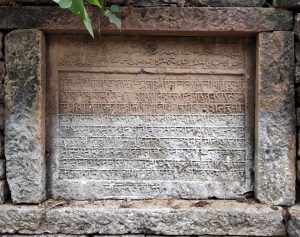
Udaypur (Madhya Pradesh). Stepwell inscription in Arabic, Persian and Sanskrit.
On a stone slab affixed into the right side wall of a stepwell known as Qanungo Baoli, located on the eastern outskirts of Udaypur, Vidisha District, Madhya Pradesh. A tri-lingual inscription of 13 lines carved in relief with the first three lines written in Arabic and Persian in nastaʿlīq script, and the next ten lines written in Sanskrit in nāgarī script. It records the construction of the stepwell by Gokuladāsa and Dāmodaradāsa, sons of Qānungo Haridāsa of Māthura kāyastha family, during the reign of Mughal emperor Shāhjahān (r. 1628-58). The date is given in three different eras—vikrama saṃvat 1701, śaka 1566 and hijri 1054—equivalent to Friday, 13 January, 1645 CE.
In the name of God, the Most Gracious, the Most Merciful. Help from God, near success. announce it to the believers (Qurʾān 61, 13). God is the best guardian and He is the most merciful of those who show mercy (Qurʾān 12, 64). This well was built in the time of His Majesty, the mighty Sulṭān Shāh Jahān ghāzī, by the servants Dāmodardās and Gokuldās, sons of Haridās Qānungo.
Success. Homage to the illustrious Ganesh. May he protect you all—the lord of lotus tanks [….] In the year 1701 from the time of king Vikramāditya and the year 1588 from Śaka Śālivāhana, when the sun was in its northward movement (uttarāyaṇa), in winter season (śiśira-ṛtu), in the most pure month of Māgha, on the 1st of the dark fortnight, a Friday, in puṣya nakṣatra (i.e. Friday, 13 January, 1645 CE) that Gokuladās and Dāmudaradās, sons of Qanungo Haridāsa a kāyastha of Māthura lineage [built this stepwell]. On 14th of the month Ḏū al-Qaʿdah of the (hijri) year 1054.